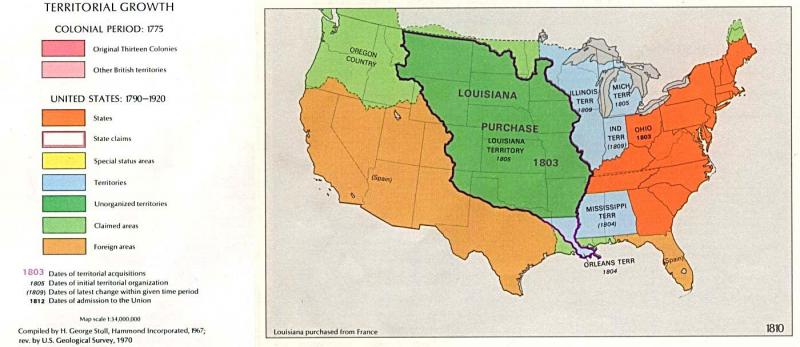U.S. territorial growth, 1810
U.S. territorial growth, 1810
Maine - Maine was a part of Massachusetts until it became a state in 1820. Until after the War of 1812, though, its boundary with British Canada was in dispute. (the disputed region is shown in light green.) Original territory - Under the terms of the Treaty of Paris that ended the War for Indepdendence in 1783, the United States included all of the territory east of the Mississippi River, north of Florida and south of Canada (which was British territory). The border with Canada was disputed until after the War of 1812. In the 1780s, Congress organized the territory west of the Appalachians and made provisions for new states to be created from it. Vermont, Kentucky, and Tennessee were added in the 1790s, and Ohio became a state in 1803. Here, states are shown in red, and other U.S. territory in light blue. Florida - East Florida (shown in orange) and West Florida (in light green) remained Spanish territory until 1819, when Spain ceded (gave up) the territories to the United States Louisiana - Louisiana was defined as all the land west of the Mississippi River that drained into it -- that is, the western half of the Mississippi River basin. It continued west to the Rocky Mountains, but its northern boundary (with Canada) wasn't clear, and both the U.S. and Britain claimed the territory in light green along the U.S-Canadian border. Oregon - Both the U.S. and Britain claimed the Oregon Territory. The two nations occupied the territory jointly from 1818 to 1846, when they divided it in half at the current border between the U.S. and Canada. Mexico - Spain still owned the territory south and west of Louisiana. After Mexico won its indepdendence from Spain in 1821, it controlled all of the territory shown here in orange until the Mexican-American War of 1846–1848.

Public Domain
Public Domain is a copyright term that is often used when talking about copyright for creative works. Under U.S. copyright law, individual items that are in the public domain are items that are no longer protected by copyright law. This means that you do not need to request permission to re-use, re-publish or even change a copy of the item. Items enter the public domain under U.S. copyright law for a number of reasons: the original copyright may have expired; the item was created by the U.S. Federal Government or other governmental entity that views the things it creates as in the public domain; the work was never protected by copyright for some other reason related to how it was produced (for example, it was a speech that wasn't written down or recorded); or the work doesn't have enough originality to make it eligible for copyright protection.